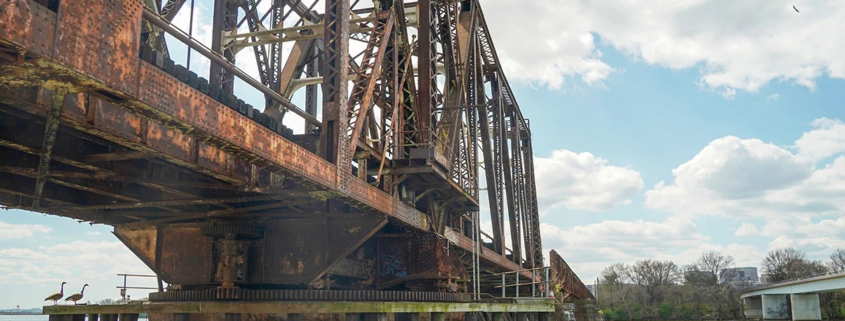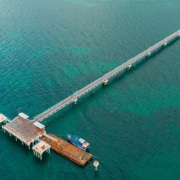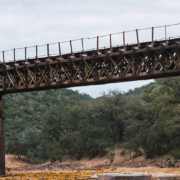Proven Strategies for Preventing Bridge Corrosion
Protecting Bridges from Corrosion: What Works and Why It Matters
Bridge corrosion is a leading cause of structural deterioration and costly repairs across the U.S. leading to billions in repair costs annually. According to FHWA, corrosion accounts for $5.9–9.7 billion in direct bridge repairs each year—with hidden costs possibly 10× higher. Nationwide corrosion expenses reach $22.6 billion in infrastructure and total over $276 billion annually.
Corrosion, caused by moisture, road salts, pollutants, and extreme weather, weakens steel and concrete, compromising bridge safety and lifespan. U.S. Bridge addresses this with smart design, high-performance materials, and preventative strategies.
Here are some of the most effective methods for combating bridge corrosion:
1. Material Selection: Hot‑Dip Galvanized Steel
Corrosion prevention begins with the right materials. At U.S. Bridge, we use high-performance, hot-dip galvanized steel in many of our structures, providing superior protection against rust and weather-related damage. Galvanization forms a physical and electrochemical barrier, greatly extending the life of steel components—even in the most challenging environments.
Benefits:
- Longer service life
- Cost savings over time
- Superior environmental durability
2. Protective Coatings
In addition to galvanization, protective coatings such as epoxy primers, polyurethane paints, and sealants create additional layers of defense. These coatings block moisture and corrosive elements, helping maintain both aesthetics and structural integrity over time. Routine recoating is a critical part of long-term bridge maintenance.
3. Design for Drainage and Maintenance
Corrosion prevention is also built into the structure itself. Proper bridge design minimizes water accumulation and improves accessibility for inspections and maintenance. Features like efficient drainage systems and strategically placed inspection ports make it easier to monitor the condition of the bridge and take timely action when needed.
4. Routine Inspections and Maintenance
Regular inspections are vital for detecting corrosion early. Signs like flaking paint, rust streaks, or pooling water can signal the beginning of deterioration. By identifying these red flags early, maintenance crews can act quickly to clean, seal, or replace affected components before the damage spreads.
5. Advanced Protection: Cathodic Systems
In coastal or industrial areas where bridges face harsher conditions, additional methods such as cathodic protection systems may be used. These systems redirect corrosive electrical currents away from vital structural elements, adding another layer of long-term defense.
6. Switching to Salt Alternatives
Traditional deicing salts contribute significantly to corrosion in colder regions. Many municipalities are turning to less corrosive solutions like potassium acetate or beet juice-based mixtures, which help keep roads safe while reducing the impact on surrounding infrastructure.
7. Economic & Societal Impact
Bridge corrosion poses significant safety risks and incurs substantial costs. A prime example is the 2022 Pittsburgh bridge collapse, largely attributed to over 15 years of neglected corrosion and failed inspections.
According to GAO reports, nearly 231,000 bridges require $125 billion in repairs, with corrosion being a primary cause. Proactive corrosion prevention is essential to reduce repair expenses, enhance safety, and extend infrastructure lifespan.
Case Study: Galvanized Truss Bridge, Miami County, OH

A prime example of corrosion prevention in action is our galvanized steel truss bridge in Miami County, Ohio, featured in Modern Steel Construction magazine (see article, pages 38–43).
This bridge spans Greenville Creek and serves as a critical connector for local traffic. Designed with hot-dip galvanized steel, it offers outstanding corrosion resistance, ensuring long-term durability and lower maintenance costs. The use of a truss structure also allowed for efficient fabrication and rapid installation—all while meeting the county’s aesthetic and environmental requirements.
This project demonstrates how thoughtful material choices, precision engineering, and protective measures can come together to create infrastructure that stands strong for generations.
Building for Longevity
According to the Federal Highway Administration, corrosion-related damage costs U.S. infrastructure billions each year. The best way to minimize these costs? Start with prevention. By choosing the right materials, designing for resilience, and staying on top of maintenance, we can extend the life of critical bridges and reduce overall repair budgets.
At U.S. Bridge, we specialize in durable, cost-effective bridge solutions that are engineered to last. From rural crossings to complex infrastructure projects, our team is here to help you build smarter and stronger.
Let’s Build Something That Lasts
Looking for a corrosion-resistant bridge solution? Contact U.S. Bridge to learn more about our design-build services and proven approach to long-term performance.





